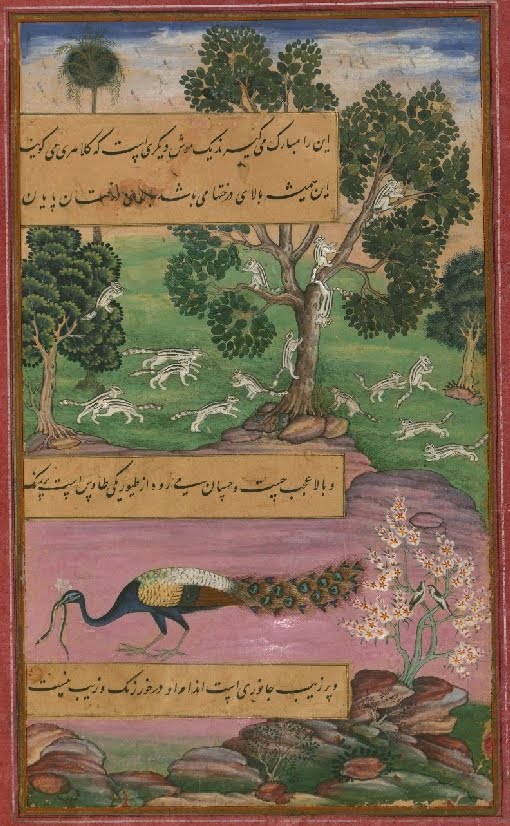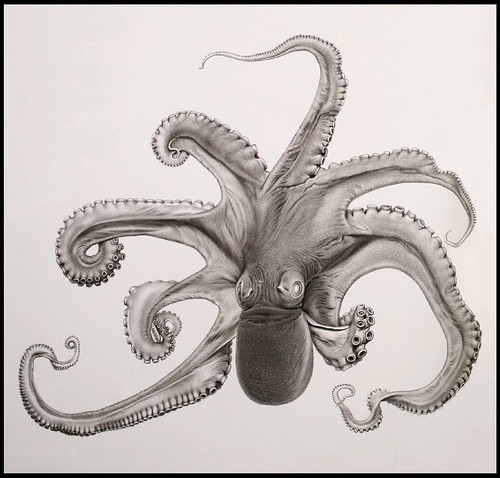Ukiyo-e woodblock prints by (Toyohara) Yoshu Chikanobu, from the late 19th century [
source]
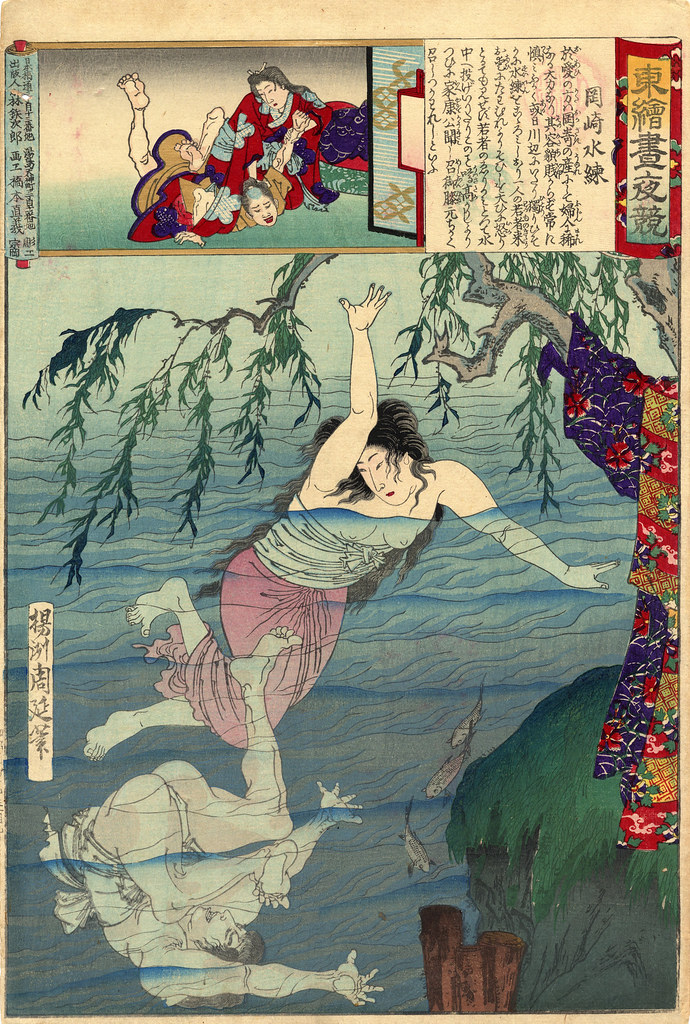
Swimming at Okazaki
Oai no kata was born in Okazaki and was both beautiful and strong, although of low social status. One day while swimming in a river, a young man tried to bother her, but she quickly defeated him. According to the cartouche, even the shogun Tokugawa Ieyasu praised her courage.
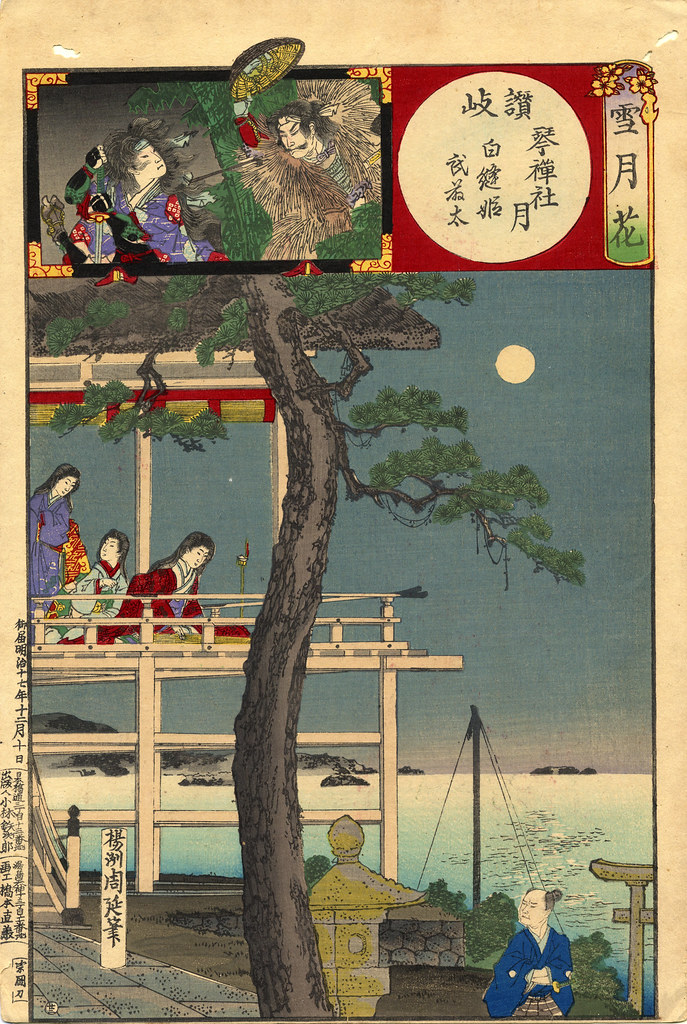
Sanuki, moon over Kotohiki Shrine, Princess Shiranui and Butoda
The Hachiman Shrine at "Zither Strumming Hill" (Kotohikiyama) gets its name from the Shinto god Hachiman of Usa, who reportedly appeared here in 703 to the sound of koto music. The hilltop shrine buildings overlook a beach famous for its many weathered pines, seen here. On the verandah a woman plays a koto, attracting the attention of a man near the shrine gate (torii). [
1884]
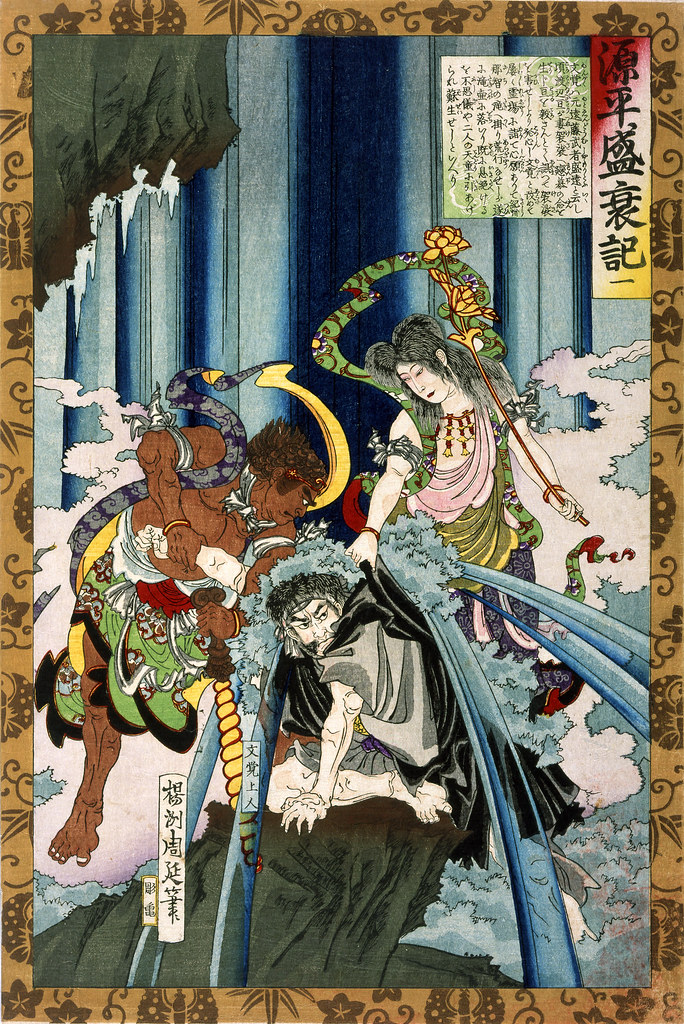
Priest Mongaku
The figure crouching on a rock beneath a waterfall is Mongaku
(1139-1203), who was born into the Watanabe military clan and initially named Endo Morito.
However, when he was in his late teens, he decided to become a Buddhist monk and changed his name to Mongaku. To test his spiritual sincerity and physical endurance, he travelled in the middle of winter to the Province of Ki where he planned to practice austerities by standing in the icy cold Nachi Waterfalls for 21 days while reciting 300,000 incantations to the deity Fudo Myoo.
After 4 days Mongaku collapsed and was carried downstream, where he was rescued and revived by one of the messengers of Fudo. Mongaku immediately went back to the falls, determined to complete all 21 days, but after just 3 days he again lost consciousness in the freezing waters. This time two divine boys, Kongara and Seitaku, seen in the print, helped him up and warmed the waters so that he could complete the three weeks of austerities.
Thereafter Mongaku was thought to have special powers given by Fudo. Several years later he would befriend Minamoto Yoritomo and help the Genji rise to power.
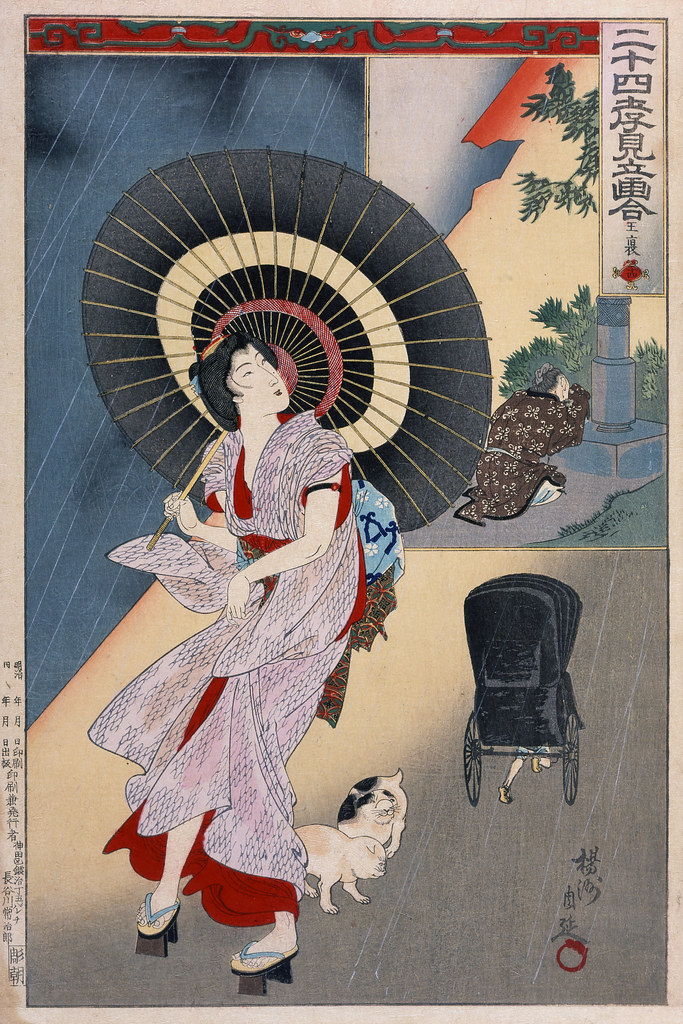
Wang Pou (Oho) visits a grave during a storm
Wangpou was so diligent about calming his mother's fear of lightning that even after her death, he would go to her tomb during a rainstorm to comfort her. By contrast, this modern woman, caught in a summer downpour, seems unconcerned by the thunder. To further emphasize the contemporary setting, Chikanobu includes a rikshaw, a new mode of transportation in 19th century Tokyo. [
1890]

Mitsunaka's dream of the Dragon Woman
In a dream, the Daughter of the Dragon King appeared to Minamoto Mitsunaka
(912-997), father of Yorimitsu and founder of the Tada Genji lineage. [
1886]
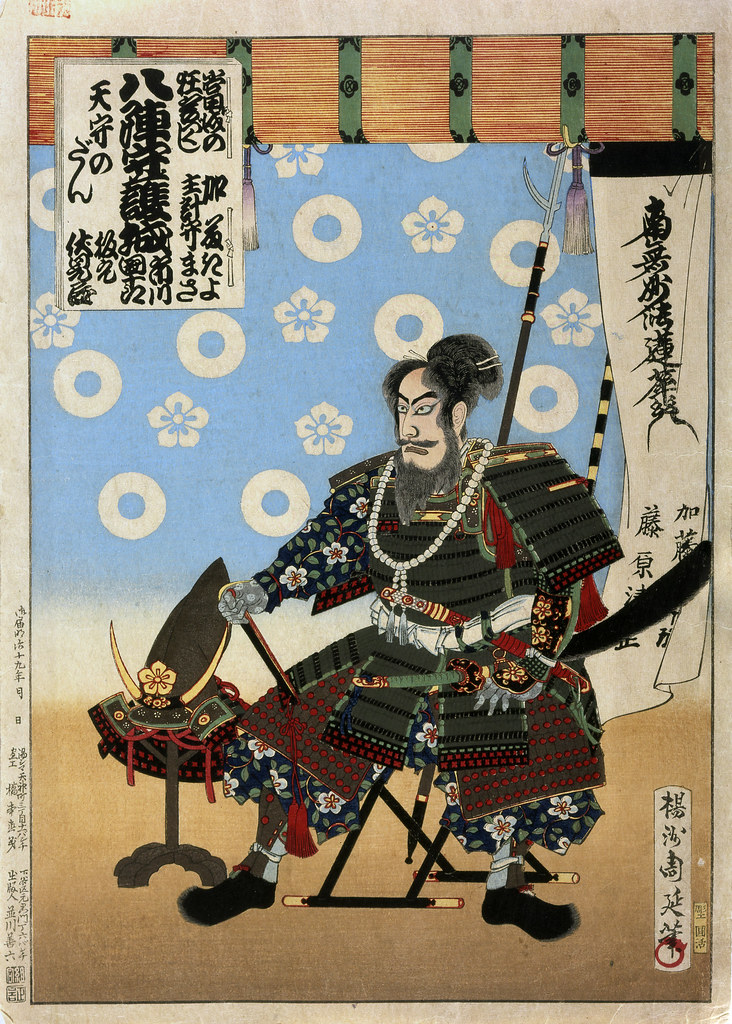
Kato Kiyomasa
The alleged poisoning of the great warrior Kato Kiyomasa
(1562-1611) was the subject of a kabuki play that premiered in 1807, but due to government censorship at the time, the main character's name was changed Sato Masakiyo.
According to legend, Masakiyo was summoned to the shoguns's castle in Kyoto and offered a cup of wine, which he knew was poisoned but which he drank out of loyalty. The lethal mix was slow acting, and allows the actor several dramatic scenes. The penultimate 8th Act takes place in Masakiyo's own castle keep where he prepares to die, seated in his armor on a campaign camp stool. Beside him is his famous battle helmet with horns flanking an oversized courtier's cap. Behind is the white banner that Kato Kiyomasa always carried into battle, with the Buddhist inscription
"Namu myoho renge kyo" (Praise to the Lotus Flower of the Everlasting Secret Teachings) a talisman supposedly written by the famous Japanese spiritual leader Nichiren
(1222-82).
In this print, Ichikawa Danjuro IX
(1839-1903) is Masakiyo, a role that resonated with the samurai ethos of devotion and duty. Kato Kiyomasa was a major political figure in the wars to consolidate Japan and a ruthless leader during the invasions of Korea in 1592 and 1597, when he was called the Kishokan (Demon General). Early in his career he had joined forces with Toyotomi Hideyoshi
(1536-98) to become one of the famous Seven Lances (Shichihon yari) of Hideyoshi during the 1583 Battle of Shizugatake.
As a reward for bravery, he was named the military governor (daimyo) of Kumamoto in southern Kyushu. As a staunch Buddhist he came into conflict on the island with other daimyo, who were recent converts to Christianity. Thus, Kiyomasa's sincere belief and vigorous support of Buddhism became an important part of his persona. In the late 19th century, Kiyomasa was again publicly popular as one of those who had promoted Japan's political interests in Korea, which was a topic of discussion in the Meiji government. [
1886]
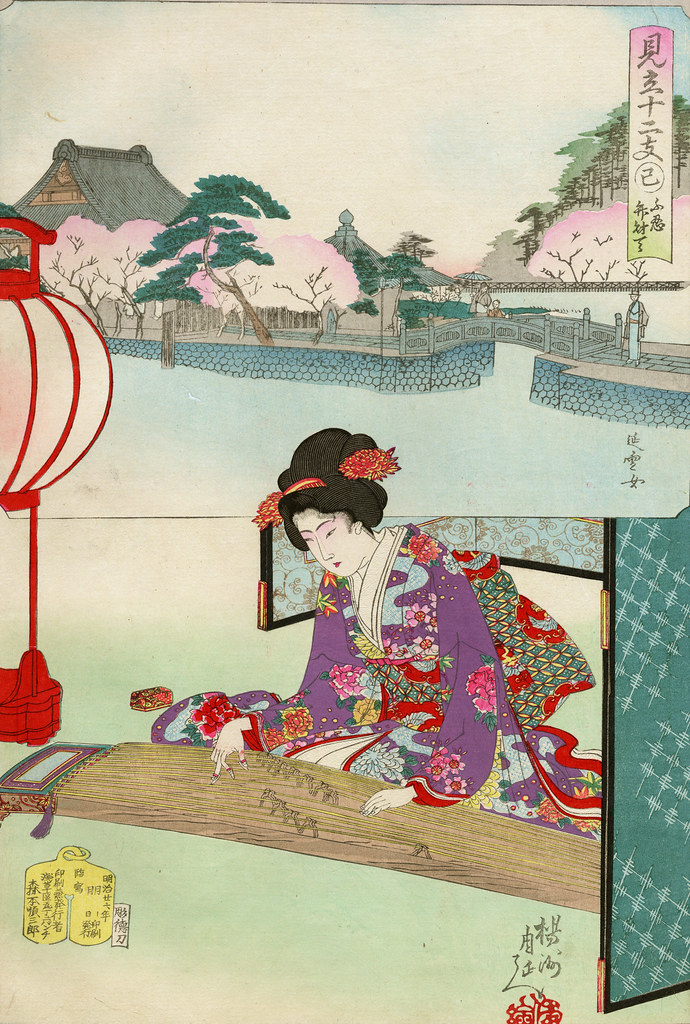
Snake: Shinobazu Benzaiten
A woman leans lightly forward to play a koto. While she appears to be inside, backed by a folding screen and seated near a paper lantern that glows softly, the inset shows blossoming cherry trees around Shinobazu Pond at Ueno, with its shrine to the Buddhist deity Benzaiten.
Snakes are associated with this goddess of music, eloquence, longevity and beauty, and with sexual passion. Images of Benzaiten often include a large white snake. The signature on this secondary image seems to indicate that the artist En'un is a woman. [
1894]
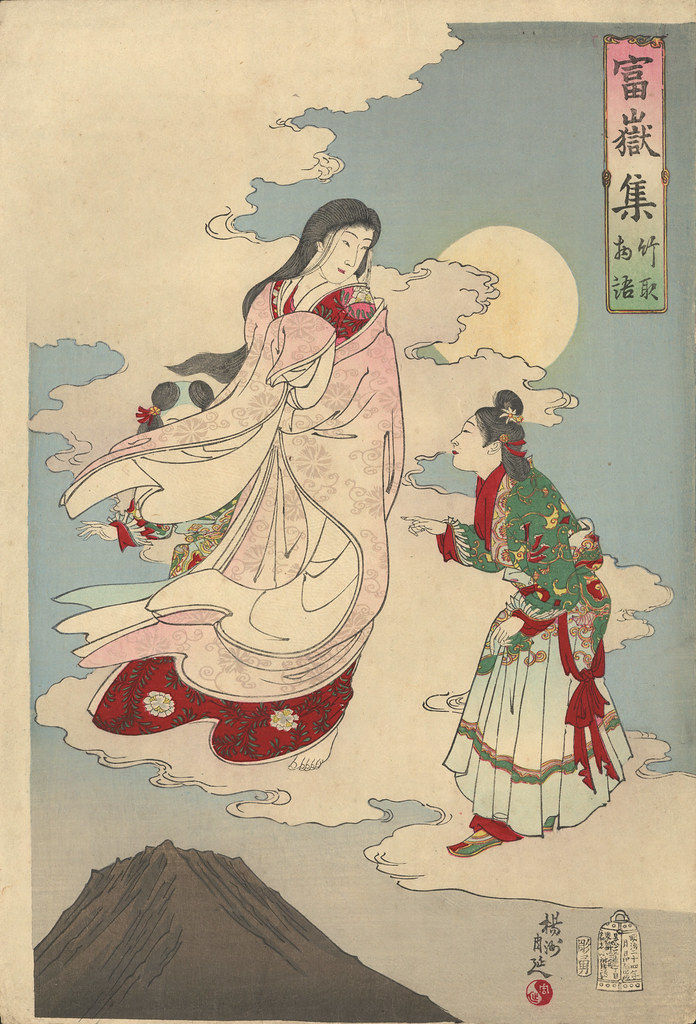
Tale of the bamboo cutter
The oldest known Japanese narrative, this sad fairy tale dates back to the 9th or 10th century. In this tale Kaguya-hime was found inside a bamboo stalk by a bamboo cutter, who took her home and raised her as his daughter.
As she grew up the fame of her beauty spread, until five princes asked for her hand. Kaguya-hime, not really wanting to marry any of them, set five impossible tasks for her suitors; when they all failed, she was able to remain with her foster parents. After this, the Emperor of Japan came to see the beautiful girl and, falling in love, asked her to marry him. He, too, was refused. However, in her 20th summer she began fall into fits of melancholy when the moon was full. Eventually she revealed she was one of a supernatural race who lived upon the moon, and it was time for her to return to her people.
Despite the emperor placing guards around her house, the moon people came and put a robe of feathers upon Kaguya-hime's shoulders that caused her to forget her earthly memories. Climbing up the slopes of Mt Fuji the party returned to the heavens where Kaguya-hime became an immortal moon maiden. [
1891]
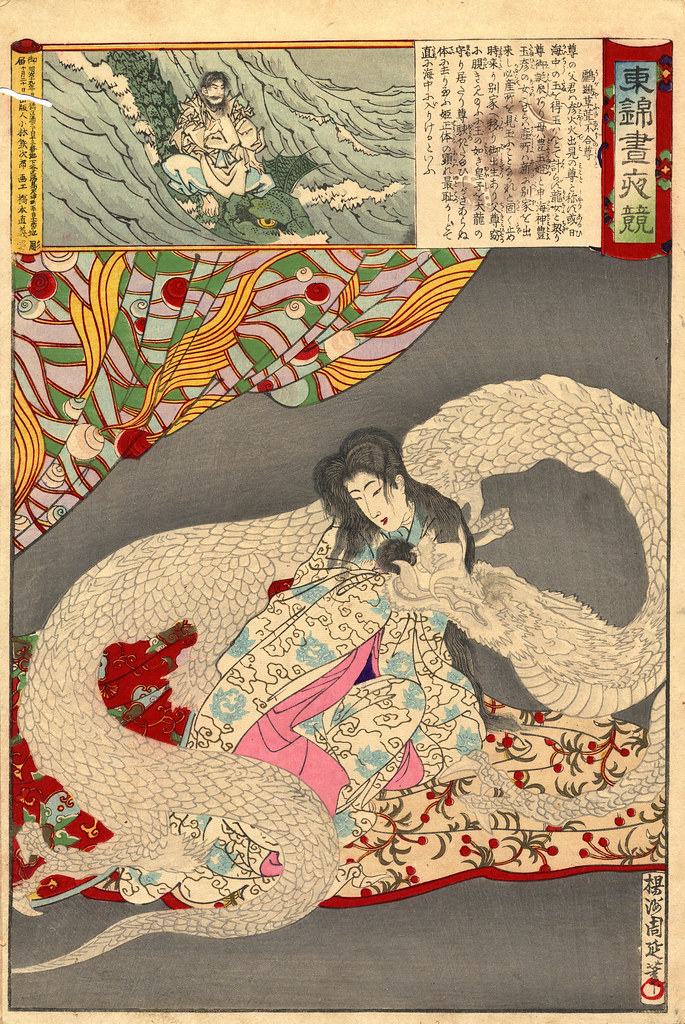
Divine Prince Ugayafuki Aezu
Princess Toyotama, daughter of the Dragon King of the Sea, gives birth to the Divine Prince Ugayafuki Aezu, by turning from her human form into a dragon. [
1886]
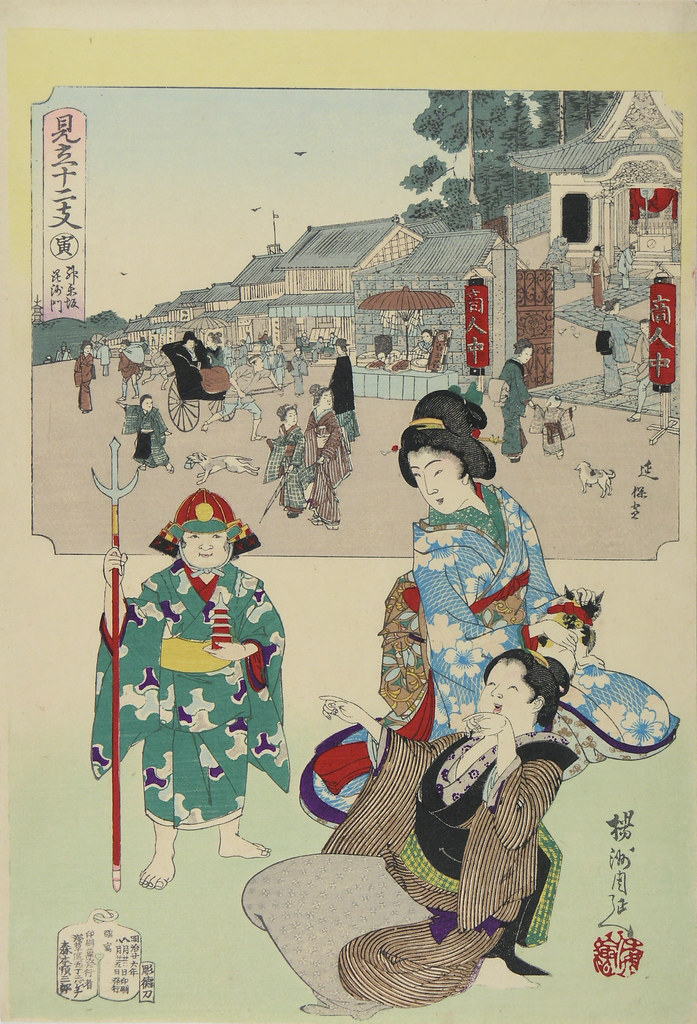
Tiger, Kagurazaka Bishamon
A boy is dressed like the Buddhist Guardian King Bishamonten, holding a trident and wooden pagoda (that represents the relics of the historical Buddha). The boy's mother holds a calico cat (a "tiger" symbol) while the family servant giggles and points at her young master. The inset shows a temple hall dedicated to Bishamonten, whose name appears on the red paper lantern inside the door.
The gateway has modern wrought iron panels affixed to a traditional stone gatepost, and a rickshaw is being pulled down the street - all indications of the modern Meiji era. However, the stores seem to be traditional buildings, and the merchants have contributed the red paper lanterns that flank the gate, reading "mid-merchants" (
shonai chu) association. [
1893]

Oshu, moon over Mano Village
Under a summer moon in Oshu (Mustu Province), Princess Nadeshiko, who had been fulling
(finishing) silk, is attacked by the robber Tsuchikuro. She parries his sword thrust by throwing a fulling mallet into his face. [
1885]
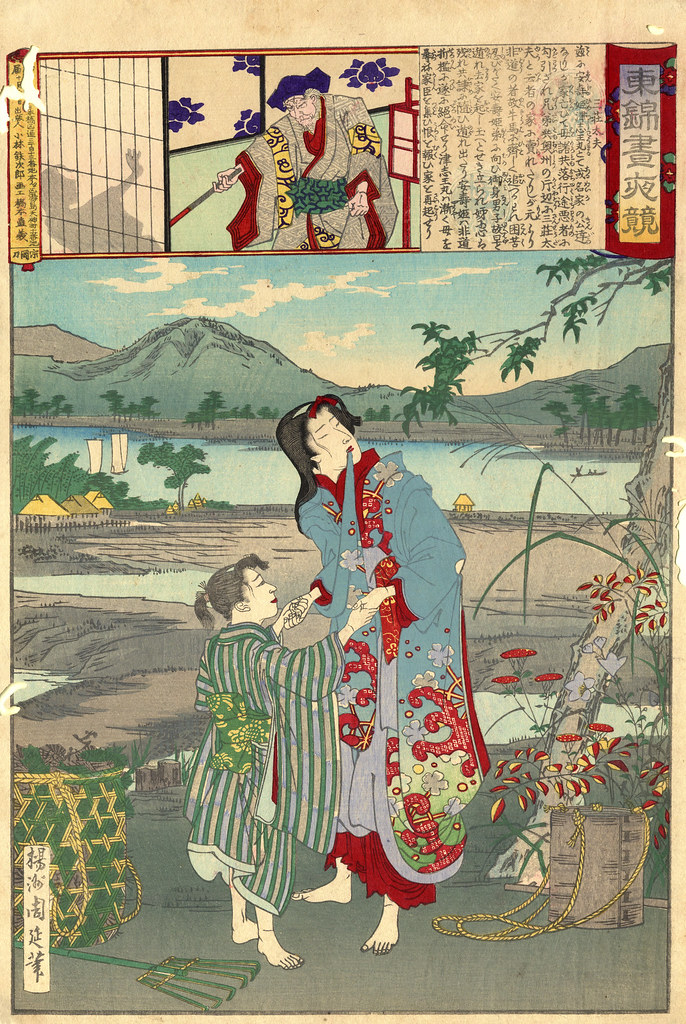
Sansho dayu
Sansho Daiyu sold into slavery Yasu-hime and Zushiomaru, the daughter and son
(shown here) of the provincial governor Iwaka Masauji, who had been overthrown and exiled.
Iwaka's loyal retainer Tatebe Kanamenosuke attempted to rescue the children, but was himself captured and sentenced to death, to be beheaded at dawn. Sansho's daughter Osan turned into a fowl as the sun rose on the day of execution and chewed off the ropes of the prisoner.
Sansho then realises that Tatebe is his long lost son, and allows his son to kill him for all his evil deeds. Then, according to the 18th century kabuki play
Yura no Minato Sengen Choja, Tatebe & Osan commit suicide.
"Yoshu Chikanobu (1838-1912) was a popular artist in the Meiji period, the era from 1868 to 1912 when Japan underwent rapid westernization and the emperor was reinstated as ruler.
Like many other print designers of these years, Chikanobu worked with subjects of traditional Japanese woodblock prints, such as actors, courtesans, famous sites, and beautiful women, while at first reflecting western conventions in art and picturing current events, such as the Saigo Rebellion and various battles of the Sino-Japanese War. In fact, his prints are frequent illustrations in history books about the Meiji era.
However, he later changed his approach and embraced more traditional themes stemming from his recollections of life in old Edo, before the modern period ushered in by the Meiji emperor."
['Chikanobu: Modernity and Nostalgia in Japanese Prints' - Vassar College]
The Yoshu Chikanobu illustrations were sourced from the Chikanobu and Yoshitoshi Woodblock Prints collection at Claremont Colleges Digital Library {Scripps College}. They have nearly 300 of his prints online.
Previously:
Japan.











